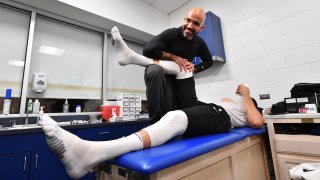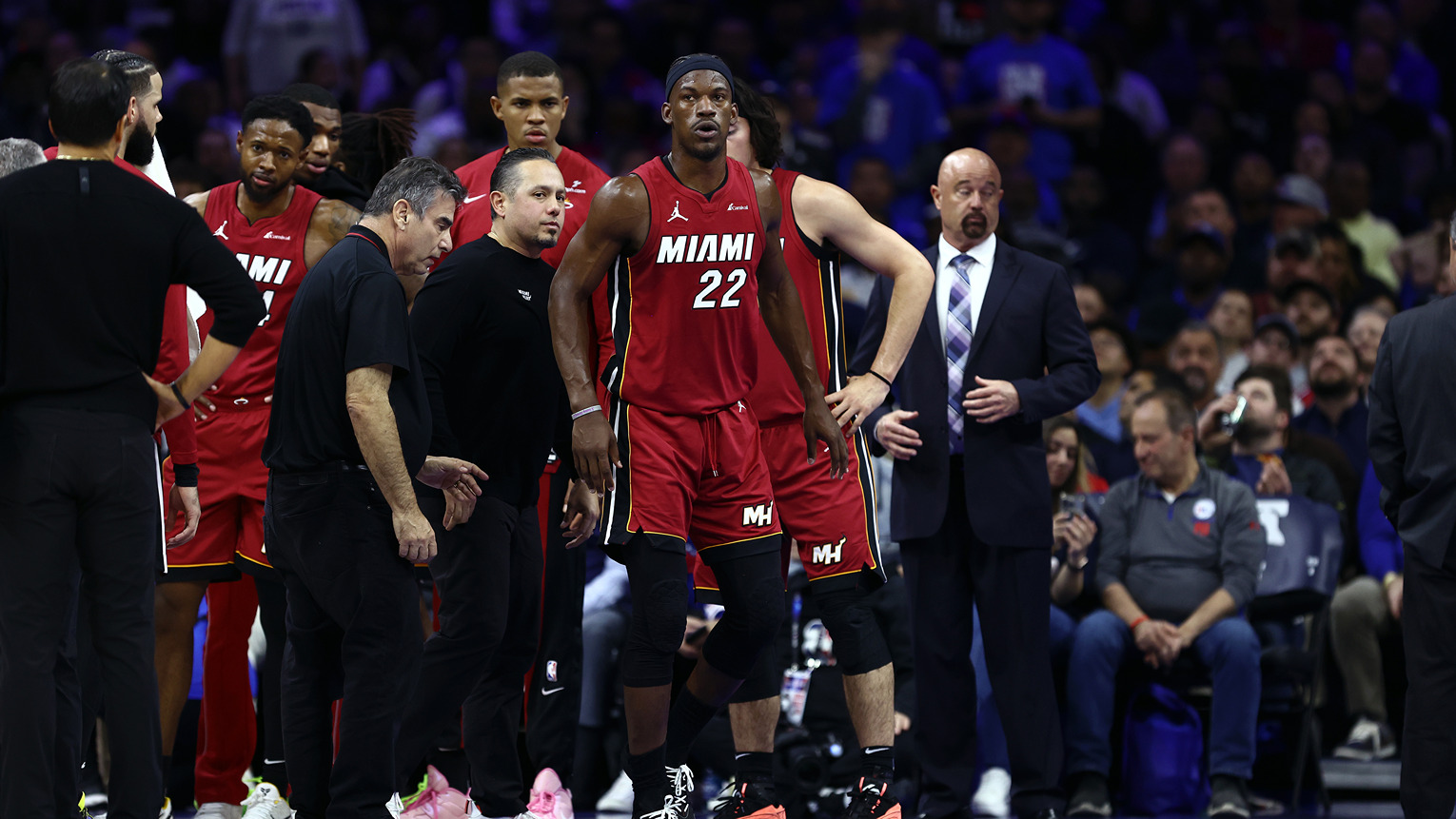
As National Athletic Training Month comes to a close, we got to know Sixers assistant athletic trainer and physical therapist Pascual Guerrero, who’s been with the organization since November 2016.
Guerrero received his BS/MS in athletic training and sports science from Long Island University, graduating in 2009, but started his career in the NFL as an intern for the Detroit Lions, where he spent two summers. As Guerrero saw the way that his field was evolving, he continued his education at Stony Brook University, receiving his doctorate in physical therapy.
Guerrero also went on to intern for the New York Knicks before landing a job in Major League Soccer, where he worked for two seasons.
Stay in the game with the latest updates on your beloved Philadelphia sports teams! Sign up here for our All Access Daily newsletter.
From taping ankles to drawing ice baths to tracking practice participation and injuries, there’s no days off when you’re a part of an NBA training staff, and there’s no place he’d rather be.
Here is our Q&A:
When someone asks you what your job entails, what do you tell them?
“So, we're not just ankle tapers … whether it’s pregame, postgame, pre and post-practice, we are working on the players’ bodies, taking them through activation exercises to get their body ready to play basketball, stretching them out as part of their cool down. It’s hydration (getting bottles of water ready), making ice bags, making ice foot baths.
NBA
“Home teams also take care of the referees, so that's another one of my duties, is checking in on the refs and making sure they are all sorted with pre and postgame needs.
“But it’s also helping out with bags and luggage on road trips. For example, waiting for our luggage truck to arrive in every city, and getting everything ready in our designated treatment room)
“There are administrative duties, too. For example, the NBA has an electronic medical record system, which we use to track things from practice participation to game participation and logging injuries.
“We keep stock of inventory, whether it’s tape, medications, braces, rehab equipment, you name it. There is no limit to what we get for the players. I mean, anything, even earwax removal Q-tips …”
(As Guerrero and I continued our conversation, there were several other duties that started to come up, like arm sleeves. Did you know that the arm sleeves players wear during a game all have to be color-coordinated? No player can wear a different colored arm sleeve than another player. Guerrero says Tobias Harris has been the primary go-to for choosing the arm sleeve colors for particular games this season.)
“I’ll generally have a feel for what [arm sleeve] they prefer given the jersey color. But sometimes they flip it on me, right before the pregame meeting, and it's a scramble to get them all together!”
(Image courtesy of Pascual Guerrero)Because you mentioned the ankle taping — how many rolls of tape do you go through?
“We go through anywhere from 24 to 28 rolls of tape in any given pregame, either at home or on the road, and that’s just of one kind of tape, not counting all of the other adjunct tapes that we use.”
And what about during the actual game? Sometimes I’ve seen you (but usually head athletic trainer Kevin Johnson) running a clipboard out to head coach Brett Brown?
“You will see a lot of the head athletic trainers carry a little notepad with them, and they're taking notes, or you see them talk to the assistant coaches. What they are doing is keeping track of timeouts and fouls during the game. It’s kind of like another quick checks and balances system, so that when a coach asks about when the next timeout is, or how many fouls do we have, etc., we can get the information out quickly to him.
“During the game, I'm usually in the tunnel, managing the bench for whatever they need — maybe it’s a hot pack or ice pack — or if the visiting team needs something, whether it’s a doctor or assistance with getting imaging done at the arena, I’m there, ready to help.”
Favorite part about your job?
“The day-to-day interaction with the guys. We see them day in and day out, we spend so much time with them, and even with our fellow colleagues in the athlete care department. It's one big family. And the thing is, we go through things together. Obviously everyone experiences the ups and downs of the season differently, but at the end of the day, we always have to remember that we're here for those 16-17 guys on the roster.
"As long as they are taken care of, in any which way that that might be, from a nice little quick banter in the morning in the athletic training room, or when you’re rehabbing someone back from an injury, getting them over that hump. It's that connection and that interaction with the players that, for me, makes it all worth it.
“And the physical nature of it, being able to get my hands on somebody and take them through a process where they are in pain and helping them realize that they’re either able to move in a very safe way, or that you're there to comfort them and help them get through that period to assure them that everything will return back to what it was. Being able to help them through that.”
Do you have off days?
“Nope. We break days into two categories — game days and non-game days — and there’s always work to be done.”
What do you think one of the biggest misconceptions about your job is?
“I’m taking this back to my athletic training program director … we are not “trainers” — the term is certified athletic trainer. We are athletic trainers. We're not personal trainers, even though we do have knowledge in strength training and conditioning players, and we do apply that in conjunction and in collaboration with our performance staff.”
Are guys particular with how they get taped or what they do before games?
“They are. Some guys don't like a lot of tape, some guys wear braces. Certain guys like to get taped at a certain time on the clock and they are very religious about their routine, even to the point where they prefer a certain table in the athletic training room at the Wells Fargo Center, and it's understood that if they show up in the room at a certain time and their table is taken by a rookie ... let’s just say it better be cleared in a heartbeat!
“One former Sixer preferred the left side table, but he had to shift to the opposite side of the room for a particular game. Well, he had such a horrible game that he literally came in the next time and was like, ‘That is my table.’ Done deal. So, no matter what, that table was always ready for him.
“And even with this team, certain guys are very particular about which tables they use. Some guys prefer to get taped and then get treatment and vice versa. Everyone's different, and when you get a batch of new guys, whether it be via trade or signings at the start of the year, it's like learning a whole new routine.”
Do you have a favorite memory with the Sixers?
“One of the neatest ones for my family was on Sixers family day, and the first year that my parents attended, Joel [Embiid] said hello to my parents and took a picture with them. I’ll never forget, because there's this picture of my mom, and I think I took it right before she actually started to smile, but Jo has his hand on her and she has a hand on his and you literally just see her, at 4-foot-9, smiling at him.”
(Image courtesy of Pascual Guerrero)Biggest piece of advice for someone looking to do what you do?
“My biggest piece of advice is get your feet wet, getting yourself out there and just applying and getting to know people. Networking. I was fortunate enough that I was able to get an internship in the NFL early on, as an undergraduate, and just made the most of it.
“During my first internship year at the Knicks, I checked in with the visiting team — it just so happened to be the Sixers. I introduced myself to the head athletic trainer, Kevin Johnson, who, in case you didn’t know, is still here! It just so happened that my previous boss at the Detroit Lions was a good friend of KJ’s. I am thankful for those early connections, which helped pave the way to now work alongside KJ, one of the most accomplished athletic trainers in the league today.
“And volunteering. I made it a habit to take advantage of any opportunity that came my way.
“That’s the wonderful thing about this profession, is that it allows you to work across many different settings. It's not just basketball. It's not just professional sports. I’ve treated anyone from your high school kid, helping them get back to the pitch or baseball field, to your elderly grandmother who had a hip replacement or a knee replacement and just wanted to be able to walk up and down her stairs without a problem. Different motivations, but it's still the same.”
Do you have a funny story you can leave us with?
“Well, KJ cuts the players’ toenails. He started it as a safety procedure, because apparently some of the guys cut themselves pretty bad. (It's well known that people go to KJ for anything foot-related). Jo was on the taping table. KJ’s cutting his big toenail and these things are flying left and right. I'm literally talking and KJ cuts a toenail and that thing flew and hit me right here (points finger to the left side of his mouth) and Jo was laughing, dying, cracking up.”
That must’ve been a giant toenail …
Click here to download the MyTeams App by NBC Sports! Receive comprehensive coverage of your teams and stream the Flyers, Sixers and Phillies games easily on your device.
More on the Sixers
-
Sixers’ Christmas win was defined by Greek Freak’s uncharacteristic loss of control
-
Sixers Talk podcast: Dr. J, A.I. The Process and our best Sixers moments
-
Embiid stars, Westbrook struggles in Sixers’ blowout 2K simulation win
-
Philadelphia athletes, Sixers managing partners join Simmons’ ‘Philly Pledge’
-
NBA considering Atlantic City for playoffs, according to report




